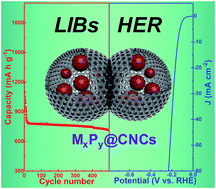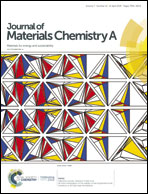Cage-structured MxPy@CNCs (M = Co and Zn) from MOF confined growth in carbon nanocages for superior lithium storage and hydrogen evolution performance†
Abstract
Metal phosphide-carbon nanocomposites with unique hollow structures are highly attractive in energy storage and conversion fields. Herein, we reported a novel strategy to construct cage-structured metal phosphide nanocomposites. A confined growth of imidazolate frameworks (ZIF-67 or ZIF-8) in carbon nanocages was reported for the first time; then, ZIF-67 or ZIF-8 was transformed in situ into metal phosphide nanocrystals through pyrolysis-phosphidation to form MxPy@CNCs (M = Co or Zn) with cage structures, i.e., MxPy cores were coated with N, P-doped double carbon shells. The cage-structured MxPy@CNCs achieved high reversible capacities (714.1 mA h g−1 for CoP@CNCs and 462.5 mA h g−1 for ZnP4@CNCs after 500 cycles at 2 A g−1) and excellent cycling performances (1215.2 mA h g−1 at 0.2 A g−1 for CoP@CNCs and 773.4 mA h g−1 for ZnP4@CNCs after 1000 cycles) when applied as anode materials for lithium-ion batteries. In addition, CoP@CNCs could serve as functional catalysts towards the hydrogen evolution reaction due to the synergistic effects of metallic CoP and N, P-doped carbon shells.



 Please wait while we load your content...
Please wait while we load your content...